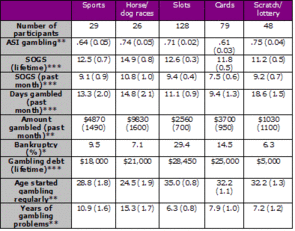In our last two WAGER’s (8(44), 8(45)), we reviewed research by Nancy Petry that examined how gamblers differ depending on treatment profiles. This week, we will discuss more research by Petry (2003) investigating whether another personal dimension, choice of gambling type, can similarly inform us about problem gamblers. To explore this question, Petry investigated the gambling characteristics of five major types of gamblers: sports gamblers, horse/dog-race wagerers, card players, slot machine gamblers and lottery/scratch ticket gamblers.
Petry recruited 347 individuals beginning treatment for pathological gambling. Each individual was asked to identify their most problematic form of gambling to determine group membership for this study. While 95% of gamblers in this study could readily identify a most frequent, problematic gambling activity, many participants also endorsed a minority participation in other forms of gambling. Eleven percent of the population was not included in subsequent analyses because they either endorsed miscellaneous forms of gambling (21 individuals) or listed “all” gambling types as most problematic (16). Inclusion criteria were DSMIV diagnosis of pathological gambling and at least one gambling day in the past month. Exclusion criteria included uncontrolled major psychiatric disorder or non-English speaking.
Pathological gambling activity was scored using the South Oaks Gambling Screen (SOGS, Lesieur & Blume, 1987), while severity of psychiatric, family/social, legal, employment alcohol and drug problems experienced with the last month were measured by using the Addiction Severity Index (ASI, Lesieur & Blume, 1991). Roughly half of the subjects were enrolled at the State of Connecticut Gambling Treatment Center, while the other half received treatment within the context of a cognitive-behavioral therapy research project.
Table 1 presents problem gambling variables for the five groups defined by gambling type. Measures that were significantly different across groups were further tested for significant post-hoc comparisons between pairs of groups. In Table 1, sports gamblers scored intermediately across problem gambling variables. The post hoc comparisons between groups showed that horse/dog-race gamblers were younger when they started gambling regularly, wagered more money and had the highest current and lifetime SOGS scores. Slot machine gamblers had a markedly high rate of bankruptcy and the highest average lifetime gambling debt. Card players had the lowest past month SOGS scores, and gambled the fewest days out of the past month. Finally, although scratch/lottery players gambled most frequently during the past month, they bet substantially less money and had the lowest lifetime SOGS scores than other types of gamblers.
Table 1. Means (standard errors) of gambling variables by group type (adapted from Petry, 2003).
* Asterisks indicate differences in P-values (*P<0.05, **P<0.01, ***P<0.001)
There are several methodological limitations to this study. For example, Petry demonstrated that problem gambling characteristics vary based on an individual’s primary problem gambling activity. However, she omitted several important variables that future studies might want to consider, such as whether individuals’ preferred gambling activity was actually what he or she consistently gambled on (Hartford, 1978). Although the most frequent type of gambling activity within the month prior to treatment correlated with each endorsement of “most problematic gambling activity”, the long-term stability of membership within a specific type of gambling and possible effects of seasonal variations on preferred gambling activity were not investigated. Lastly, results were limited only to a treatment-seeking population in Connecticut; non-treatment seeking populations or problem gamblers located in areas with varying types of games might differ from this sample.
Further research in this area could help to determine whether particular forms of gambling might be more problematic than others. For example, do some games stimulate gambling problems more rapidly than others; is it more difficult to control play at certain games more than others; do some games interact with specific risk factors to exacerbate the development of gambling-related problems? By completing large, nationwide population surveys of heterogeneous types of gambling, researchers might be able to discover whether underlying vulnerabilities predispose certain populations to different forms of problem gambling. Although further research is needed to identify these issues, treatment providers should be aware of a possible association between individual characteristics, preferred gambling activity and actual gambling patterns. Such awareness could inform their assessment and treatment of those seeking help for gambling related problems.
Comments on this article can be addressed to Fred Sheahan.
References
Hartford, R.J. (1978). Drug preferences of multiple drug abusers. Journal of Consulting and Clinical Psychology, 46, 908-912.
Petry, N.M. (2003). A comparison of treatment-seeking pathological gamblers based on preferred gambling activity. Addiction, 98, 645-655.
Lesieur, H.R., & Blume, S.B. (1987). The South Oaks Gambling Screen (SOGS): A new instrument for the identification of pathological gamblers. American Journal of Psychiatry, 144(9), 1184-1188.
Lesieur, H.R., & Blume, S.B. (1991). Evaluation of patients treated for pathological gambling in a combined alcohol, substance abuse and pathological gambling treatment unit using the Addiction Severity Index. British Journal of Addiction, 86, 1017-1028.





